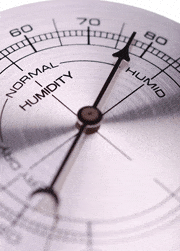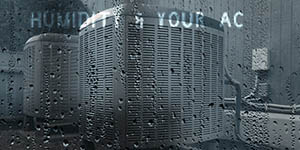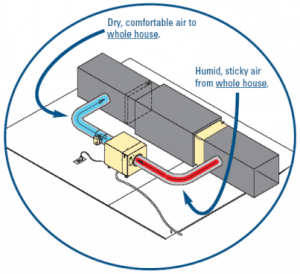Prioritizing Houston Humidity Control

"It's not so much the heat, as it is the humidity." - A phrase all too commonly known in Houston homes - It's true, Houston summers can be both sizzling and sticky, but it's the combination of both the heat and humidity that contributes to Houston's often uncomfortable summer conditions. Just step outside on a summer day and and it’s impossible not to notice the effects of our humid climate and just how it amplifies the already existing high temperatures. At Adams Air, we're Houston homeowners too and that's why we understand the importance of controlling humidity levels, especially in Houston. Thankfully, when it's muggy outside, it no longer has to be muggy inside, and this is why a whole home dehumidifier makes a great addition to any Houston home.
Symptoms of High Indoor Humidity
- Mold and Mildew Present On or Behind Walls.
- Condensation Forming on Windows, Mirrors, Pipes or Walls.
- Peeling Paint or Wall Paper.
- Warping or Rotting of Wooden Floors, Trim, or Wooden Furnishings.
- Mold or Fungi Growing on Wooden Beams, Stairs Or on/within Books.
- Musty Smells and Odors.
- A 'Sticky', 'Muggy' or 'Clammy' Feeling/Sensation at Normal Temperatures and the Inability to get comfortable at Normal Temperatures.
- An increased presence of insects indoors.
- Frequent Allergic Reactions or Asthma Flare-Ups Indoors.
Humidity and Temperature
How Temperature (°F) and Humidity (%RH) form the Heat Index
| 90% RH | 80% RH | 70% RH | 60% RH | 50% RH | 40% RH | |
|---|---|---|---|---|---|---|
| 80°F | 85 | 84 | 82 | 81 | 80 | 79 |
| 85°F | 101 | 96 | 92 | 90 | 86 | 84 |
| 90°F | 121 | 113 | 105 | 99 | 94 | 90 |
| 95°F | 133 | 122 | 113 | 105 | 98 | |
| 100°F | 142 | 129 | 118 | 109 | ||
| 105°F | 148 | 133 | 121 | |||
| 110°F | 135 |
Humidity and Your Air Conditioner

We all know air conditioners help control the temperature of the air in our homes, but did you know humidity affects just how well your air conditioner controls air temperature? Humidity is the measurement of how saturated the air is with water moisture, and that water moisture in the air contains heat (This is why on hot and humid days we feel hotter than what the thermometer is actually reading) which makes our air conditioners have to work extra hard to cool down the air in our homes. This is because before our air conditioners can cool down the air, they must first remove the moisture from that air, and when humidity levels are high, this essentially cancels out the air cooling effect our air conditioners are designed to provide.
So what exactly does this mean for Houston air conditioning systems? Since Air Conditioners are designed to condition and cool down the air in our homes, when that air contains lots of humidity (which is often in Houston) our air conditioners have to run longer in order to reach the desired temperature set on our thermostats. This means higher utility bills, more repairs, and shorter life spans for Houston air conditioning equipment, which is another reason a whole home dehumidifier is a great addition to any Houston air conditioning system - Providing not only comfort benefits, but efficiency benefits as well.
Humidity and Indoor Air Quality
Indoor Air Pollution Influenced By Humidity
| Pollutant | Pollutant Information |
|---|---|

|
Biological Pollutants - Includes air borne organisms that cause illnesses, allergic reactions, respiratory ailments and infections such as: Viruses, Mold, Fungi, Bacteria, and other air borne biological contaminants including proteins found in dried mouse urine, insect debris and droppings, cat and dog saliva. |
The EPA (Environmental Protection Agency) recommends that indoor relative humidity levels should be maintained at around 50% - It is when humidity levels become too high or too low that indoor air quality declines due to an increase in indoor biological pollutants, see below:
Humidity and Indoor Air Quality

Houston generally doesn't have any issues with low humidity levels since our city is located so close to the equator and the Gulf of Mexico, but high humidity levels are common and most homes fail to maintain a recommended 50% relative humidity indoors. As shown above, humidity levels above 50% provide a thriving breeding ground for insects, dust mites, bacteria, viruses, fungi, mold, allergens, and the concentration of other biological indoor air pollutants. Testing your home's indoor relative humidity levels is simple: Relative Humidity gauges (also known as hygrometers) can be picked up at most hardware stores and if any of these indoor air quality issues are a concern in your Houston home, Adams Air recommends the addition of a whole home dehumidifier to your air conditioning system which not only provides comfort and efficiency benefits, but healthy indoor air benefits as well.
For more information on our whole home dehumidifier set-ups, select the tab at the top of the screen.
Whole Home Dehumidifiers

Is Houston's high humidity levels causing discomfort or indoor air quality concerns in your home? We all know the signs: Sweaty windows, stale odors, and that sticky uncomfortable feeling we get when humidity levels are high - Thankfully we can put an end to these symptoms with the addition of a Whole Home Dehumidifier to any existing central air conditioning system that manages and optimizes indoor humidity levels all day long.
Managing your home's indoor humidity level is a big factor in creating a healthy and comfy indoor environment - Too much humidity can encourage mold and bacteria growth, musty odors, and provide a cozy home for dust mites and other pests to flourish which can trigger allergic reactions and asthma in people sensitive to these issues. And high indoor humidity levels can not only make everyone in your home uncomfortable, but your wallet as well - Humidity contains heat which puts a strain on our air conditioners because that heat contained within the moisture in the air has to be removed by our air conditioners. Because of this we tend to drop the temperature lower than we need in order to satisfy our comfort levels and alleviate that sticky, clammy feeling we get from all the humid moisture that's saturated in the air. This means air conditioning systems end up having to run longer and work harder in order to keep up with our demands - Whole Home Dehumidifiers address all of these issues and deliver a healthy, comfortable, efficient living environment to any Houston home, all year long.
How Whole Home Dehumidifiers Work

Installed along side your current air conditioning system, a whole home dehumidifier draws in air from your air conditioning system's return air intake. This warm and humid air is then pulled inside the whole home dehumidifier unit where it is rapidly cooled and this causes the moisture in the air to get squeezed out and condensed into water droplets which is then collected and drained away. Some whole home dehumidifiers can remove upwards to 25 gallons of water per day, and in Houston's humid climate that amount of latent moisture is not that uncommon. Removing all this moisture from the air allows an existing air conditioning system to do what it's designed to do - Condition and cool the air, not dehumidify it, and 25 gallons of water removed by a whole home dehumidifier is 25 gallons of water the air conditioner doesn't have to strain to remove on it's own. This all translates to cooler and crisper air, faster all while reducing the work and run time of the air conditioning system itself and in turn lowering utility bills.



Whole Home Dehumidifiers vs Portable Dehumidifiers
Portable Dehumidifiers vs Whole Home Dehumidifiers
| Portable Dehumidifer | Whole Home Dehumidifier |
|---|---|

|

|
Other than providing benefits to the entire home, lets explore the other benefits a Whole Home Dehumidifier can provide that portable units simply cannot.
Moisture Removal Capacity
The biggest difference between a whole home dehumidifier and a portable dehumidifier is capacity, or the amount of moisture it can remove at any given time. Whole Home Dehumidifiers have a larger compressor and cooling coil than portable units, which means they have a larger capacity and remove more moisture from the air at a faster rate and are effective in larger spaces. Portable manufacturers often inflate their unit's performance by basing their capacity off tests run in an environment that consists of 100% relative humidity (which is a scenario that rarely occurs). Under these conditions moisture is readily available and easier to remove, making it easier for the manufacturer to inflate the performance of their portable units. But in a much more realistic environment, a portable dehumidifier's performance is actually quite lower.
Whole Home Dehumidifiers are rated for performance scenarios regulated by the AHAM (Association of Home Appliance Manufacturers) which sets the standard for whole home dehumidifier performance at 80° F at 60% relative humidity. This means if a whole home dehumidifier is specifying that it will remove 250 pints of water a day, you can expect that it will come pretty close to that capacity.
Moisture Drainage

All the moisture a dehumidifier extracts from the air has to go somewhere - Portable dehumidifiers generally drain the moisture they remove from the air into a small bucket located inside the unit which throughout the day has to be periodically emptied by hand other wise the portable unit will shut off until the bucket is emptied so it doesn't over-flow into your home, which means they constantly have to be monitored and attended to in order for to achieve any level of effectiveness.

Other portable dehumidifiers drain all their condensate through a drain hose which can be adapted into the home's plumbing if gravity permits. In most cases portable dehumidifiers sit too low to the ground to drain into a home's internal plumbing, but they can be adapted to drain into a pump, which then can pump the condensate water to a desired location or up-hill to the home's internal plumbing stack in order to continuously drain. Utilizing pumps and hoses however can be very unsightly within a home due to the presense of a loud pump and a long hose running across the floor.

Whole Home Dehumidifiers, like your central air conditioning system, drain into the plumbing of your home where the water is automatically carried away and offer a worry free unlimited run time whether your home or away. Just like you're existing HVAC system, a Whole Home Dehumidifier is installed in the attic which allows it to drain directly into your home's internal plumbing just as your AC system does.
Air Movement
Most portable dehumidifiers do not list or disclose their CFM rating (how many cubic feet of air per minute they move across their cooling coils). CFM is a very important factor when determining the size of the room the unit is designed to function within - Smaller units without adequate air flow will not be able to adequately dehumidify larger areas.
Whole Home Dehumidifiers on the other hand do disclose this information and are equipped with much larger fan units. Whole Home Dehumidifiers also tie directly into your air conditioners duct work, which makes the most efficient use of their fans CFM.
Control Functions
Whole Home Dehumidifiers can tie directly into the thermostat that you use to control your air conditioning system and display both indoor temperature and indoor humidity controls allowing you to adjust not only temperature, but humidity as well, and from the same thermostat - Set it and forget it, or have it automated through your air conditioning systems programming or even access it's control via any wifi enabled smart device. Portable units don't offer these functions and will eventually shut off if left on too long due to the limited size of their drainage buckets.
Energy Efficiency
Portable units that plug into the wall sockets of your home utilize electricity at 120 volts, which means they consume more electrical current vs whole home units that are operating at 240 volts along with your air conditioner - Just as with portable air conditioners or window units, running portable dehumidifiers translates into higher electric bills. And since whole home units dehumidify the air in your entire home, you'll enjoy a higher efficiency rating from your air conditioner because it will cool down the air in your entire home faster which means the air conditioner won't have to run nearly as often.
Types of Whole Home Dehumidifiers

In the world of mechanical whole home dehumidifiers there are essentially 2 types of systems with the difference being where the condenser coil component of the dehumidifer is physically located - Either indoors or outdoors. Like an air conditioning system, a dehumidifer uses a compressor to pump refrigerant through both an evaporator coil and a condenser coil. The evaporator coil is the component that gets cold and when the air in your home passes over this cold coil, the moisture in the air gets condensed out of the air and is collected and drained away, effectively dehumidifying the air. Consequently there is also warm condesner coil that accompanys the evaporator coil. When the condenser coil is located inside, the sensible heat from the condenser coil also gets added to the air in the home. Because of this added heat, manufacturers have developed split dehumidifiers, and just like an air conditioning system, the condenser coil gets located outside where it's heat cannot affect the indoor temperature. The downside to these dehumidifiers is that although they conserve energy by removing the condenser coil's heat load off the air conditioning system and provide greater comfort benefits, they also intitially cost more to install because refrigerant lines have to be ran from the indoor unit to the outdoor unit.
Q: How bad is the heat load added by a non-split dehumdifier?
A: About as bad as a handful of light-bulbs and a television.
Whole Home Dehumidifiers With Ventilation Functions
Houston Indoor Humidity Control Experts
So are you ready to dehumidify your entire home and say goodbye to Houston's muggy weather? Adams Air representatives are available 7 days a week to answer any of your Whole Home Dehumidifier questions and offer competitive family operated rates any Houstonian would be proud of. Our whole home dehumidifiers will ensure peak performance out of your existing air conditioning system and provide healthy air and comfort benefits to your home and family for years to come. For more information or to schedule your whole home dehumidifier consultation, call (281)-375-2011 or contact Adams Air via the form below and we'll call you back in no time.
Send us an Email
 Air Purification
Air Purification
From Dust, Pollen, Odors and Chemicals, to Mold and Air Borne Viruses such as the Flu - Our whole home air purification systems filter out indoor air pollution and provide the healthy and clean air you and your home deserve.
Read More Humidity Control
Humidity Control
Houston's climate may be humid and sticky, but it doesn't mean your home has to be - Our whole home dehumidifier systems work to keep the air in your home crisp and comfortable while reducing mold, fungi, and insect growth.
Read More Ventilation
Ventilation
Our Home Ventilation Systems automatically ventilate stale and polluted indoor air to the outside environment and bring fresh, oxygen rich outdoor air in our homes in order to reduce the accumulation of indoor air pollution.
Read More Ductwork
Ductwork
Air Flow is the most important aspect of an HVAC system, and often the most over-looked. From Ductwork modifications and repairs, to complete re-works and installations - Adams Air is Houston's Premier Ductwork Specialist.
Read More
